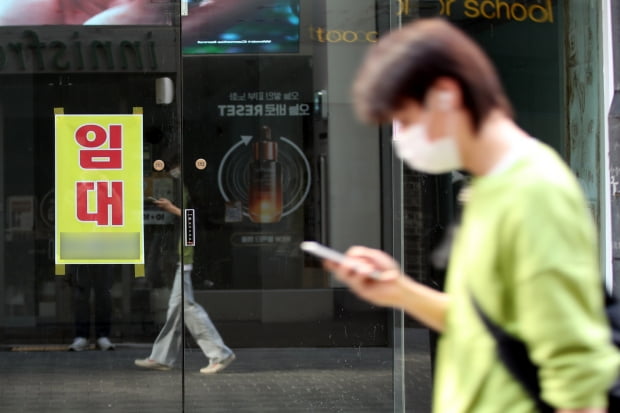250,000 self-employed people facing’liquidity crisis’
Concerns about zombieization in 4 out of 10 companies next year
Household debt ratio exceeds 100% for the first time in history

There is a rental banner on the building in Myeong-dong, Jung-gu, Seoul. Photo = News 1
As the Corona 19 crisis continues until next year, it is expected that the living lives will deteriorate to the extent that 250,000 households running self-employed businesses cannot handle the basic spending of eating and drinking. The number of self-employed households that are forced to close next year are expected to reach 50,000. The impact of Corona 19 is expected to be concentrated, as the small self-employed who endures in debt will fall into a’weak link’ in Korea.
I endure in debt… In front of the crisis
According to the’Financial Stability Report for the second half of 2020′ released by the Bank of Korea on the 24th, out of about 2437,000 self-employed households (households whose owners are self-employed) due to the Corona 19 shock, 10.4% of households that will experience a’liquidity crisis’ at the end of next year (approx. 253,400 households). The liquidity crisis refers to a situation in which it is difficult to repay loans at maturity and basic expenditures to live even after breaking deposits and savings and selling financial assets such as bonds and stocks. This is an estimate based on the scenario that the sales of self-employed people will deteriorate next year due to Corona 19, and the government and financial companies will end the deferment of repayment of principal and interest for small business owners on March 31 next year. As such, the proportion of self-employed households experiencing a liquidity crisis was only 2.3% in February of this year, just before Corona 19. However, it rose to 7.5% in December of this year and is expected to rise next year.
In this’pessimistic scenario’, the number of self-employed households that are unable to pay off their liabilities even if they sell all assets such as real estate while experiencing a liquidity crisis is expected to soar to 2.2% (53,600 households) at the end of next year. It surged from 0.4% in February this year and 0.9% at the end of this year. It was found that such self-employed households mostly shut down their own households to pay off their debts.
The deterioration of self-employed households is the effect of a sharp decline in sales of self-employed people with many face-to-face transactions due to the prolonged Corona 19. The amount of loans for self-employed persons at the end of September was 77.4 trillion won, a 15.9% increase from the same period last year, as debts covered operating funds, which had become insufficient due to the sales gap.
Mass production of zombie companies
The ratio of household debt to nominal GDP reached 101.1% at the end of the third quarter of 2020, up 7.4 percentage points from the same period last year. This is the first time it has exceeded 100% since 1975 when related statistics were written. At the end of the third quarter of this year, household debt (including those of small self-employed persons) reached a record high of 1940 trillion won. During the same period, nominal GDP (from the fourth quarter of last year to the third quarter of this year) reached 181.8 trillion won.
The household debt ratio jumped from 89.4% at the end of 2017 to 91.8% in 2018, exceeding the 90% range and then to 95.2% at the end of last year. In the third quarter, it exceeded 100% with 101.1%. The surge in household debt is the result of increased borrowings raised by households to finance the purchase of real estate, which has been overheating this year. A BOK official said, “If the economic recovery is slow in the future, the risk of insolvent household debt may increase.”
The so-called’zombie company (Limited Enterprise)’, which can not even pay interest with operating profit, is also a ambush of the Korean economy. The BOK estimates that out of 2298 external audit firms, the proportion of companies with an interest coverage ratio of less than 1x will reach 39.1% next year. It was calculated on the premise that the’pessimistic scenario’ that the company sales for next year will decrease by 1.7% compared to this year due to Corona 19 has been realized.
The interest compensation ratio is the value obtained by dividing the operating profit by the interest expense. If this ratio is less than 1x, it means that the operating profit cannot cover the interest expense. The proportion of companies with an interest compensation rate of less than 1x fell to 35.7% in 2018 and 35.4% in 2019, but this year it has risen to 37.5% due to Corona 19 and is expected to continue rising next year.
In the pessimistic scenario, the probability of default by company also increases from 1.41% this year to 1.59% next year. A BOK official said, “The uncertainty in corporate management conditions has increased due to concerns about the weakening of the global economic recovery,” and said, “We need to prepare for the possibility of increasing corporate credit risk.”
Reporter Kim Ik-hwan [email protected]
